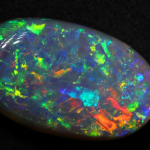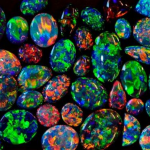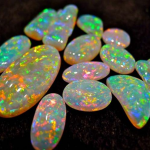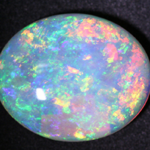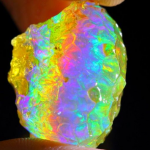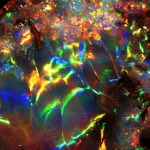Contents
Opal Information
Considered from the ancient time one of the most beautiful stone, Opal is a composition of silicon dioxide with a variable amount of water, its names mean “valuable stone” and comes from the Sanskrit. Considered the national stone of Australia, Opal can be divided in: precious opal, fire opal and common opal also called: potch.
The distinctive characteristics of this gemstone is the optical effect called opalescence, an attractive play of color caused by small spheres of silica gel that cause interference, refraction and diffraction of light, resulting in the beautiful multicolor opalescence visible on the surface of the stone.
Opalescence is a sort of adularescence and commonly used to describe the common colors of this stone, “play of color” is a distinctive term to describe only the precious Opals iridescent effect.
Precious Opal is considered the variety characterized by the display of play of color that can include all the rainbow color like: yellow, green, orange, blue, purple, red.
Fire Opal can also show opalescence in rare cases, but its name is referred to their body color (orange, red, yellow) that resemble the fire flames. Can be transparent to translucent and they are usually mined in Mexico
Common Opal, also called “potch” by miners, usually does not show the display of colors exhibited in precious opal. Common opals show a milky clarity and white or cream color.
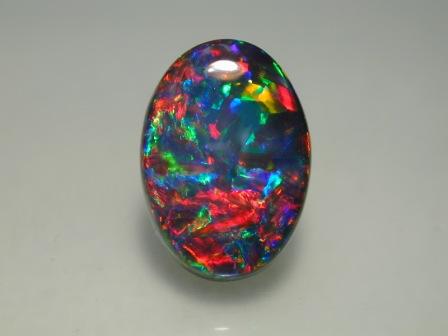
Click here to purchase natural Opals
Healing Properties
Natural Opal for years was considered a stone that, with its bright colors, helps to solve depressions, inspire creativity and originality, Duo to its porous composition is considered a receptor and can absorb negative energy and amplify joy and happiness, allows the release of inhibitions inspiring love and passion.
It is considered the October birthstone, is a perfect gift for a mother.
Treatment
It is usually untreated and it cannot be treated in the common way like for any other gemstone, it is composed by water so it can’t be heat or irradiated, but some well know treatment are nowadays applied to enhance the appearance of the stone or to resemble bad quality stones to the more precious variety like Australian black Opals.
On the gem market can be easily found some doublets or triplets stones, where a thin layer of Opal is attached to a darker matrix to enhance color and durability.
Natural stones comes with a white body color (like material from Ethiopia) can be smoked to resemble the more valuable australian black Opal.
In some rare case they can also be dyed, or impregnated with oil, resin or plastic to enhance color.
Synthetic stones exists and they try to simulate the appearance of natural Opal gems.
Click here to purchase loose natural gemstones
Origin and gemstone source
The origin of this gemstone are various, it can be mined in a lot of localities and countries, but the most precious variety is the Black Opal mined only in Australian.
Famous deposit of Australian Opals are: Lighting Ridge, Coober Pedy, Andamooka, Queensland.
Other variety of this stone can be mined in Ethiopia (white body color and sometimes in rare case with black tone), Mexico (fire Opal with orange or red color), Honduras, Perù, Brazil, Indonesia, Russian Federation, United States, Indonesia.
Optical Effect
Opalescence is the common optical effect typical of natural stones, a kind of pearls like adularescence typically blue in color accompanied with a milky clarity.
Play of color is the optical effect attributed to the precious Opal stones with a nice iridescence on the surface, caused by light diffraction, that can include all the color of the rainbow, like: yellow, green, blue, orange, red, purple.
Yellow, blue and green are common, red, violet and orange are rare to find and considered more valuable.
Images and photos
Click here to purchase natural Opal gemstones
Uses
This is a relative ancient stone, nowadays it became a popular and appreciated stone by customers, it is not really hard and is considered a delicate stone, but its attractiveness and unique color patterns can really be considered eye catching.
Usually cut into cabochon to display in the appropriate way the typical “play of color” of the most precious gemstones, jewelers loves to set into a high end jewels, duo to its low hardness and delicate nature, they are often set into pendants or earrings instead of rings and bracelets.
Usually cut into cabochon to display play of color, in some rare case some little stones can be faceted into popular shape like ovals, emerald octagonal, pear, round or marquise shape, especially the common opals variety.
Care and Cleaning
Considered a delicate stone, they need some cure. Composed by water, if dried, Opal gems can easily cracks, someone stores them into jar filled with water, some other store their Opal gemstones enclosed with wet cotton in a plastic bag.
Remember that Opals are quite soft and can be scratched, by any harder stone like amethyst, topaz, ruby, emerald and more, so store them separately from other stones.
Avoid steam or ultrasonic machine and any chemical products, also be careful exposing them at high temperature, because they will be destroyed by heat.
Scam and Fraud
Synthetic man made stones, doublets, triplets, smoked and dyed opals are really accessible on the gem market, often sold for natural untreated Opals, always ask the seller about the treatment applied to the stone if any.
Click here to purchase natural gemstones
Gemological Info
- Mineral family: Opal
- Crystal: Amorphous
- Density: 1.98 – 2.15
- Hardness: 5.5 – 6.5
- Refractive index: 1.37 – 1.52
- Color: white, black, orange, yellow
- Luster: Vitreous
- Clarity: Resinous to Waxy
- Fluorescent: white, bluish, brownish, greenish (white opal) – greenish to brown (fire opal)
- Cleavage: None
- Durability: Moderate
Click here to purchase natural Opal gemstones


